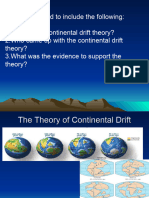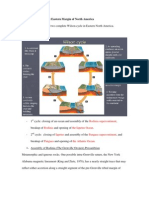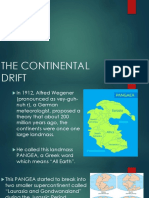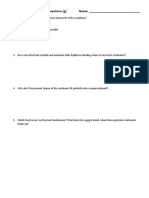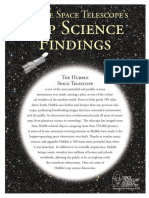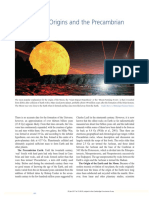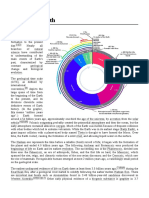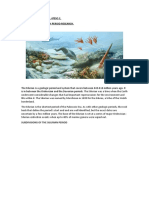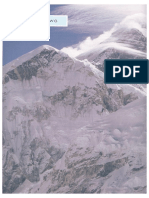100%(1)100% found this document useful (1 vote)
39 viewsPlate Tectonics Supercontinent
Plate Tectonics Supercontinent
Uploaded by
Razi AbbasThe document discusses the supercontinent cycle of formation and breakup of supercontinents over geologic time. It describes how the supercontinent Pangaea formed 300 million years ago from the collision of smaller continents. Pangaea then began to break apart about 250 million years ago into the continents of Laurasia and Gondwanaland. The modern positions of continents were achieved between 50-70 million years ago as the pieces of Pangaea continued drifting apart. The supercontinent cycle of assembly and breakup repeats over billions of years.
Copyright:
© All Rights Reserved
Available Formats
Download as PPT, PDF, TXT or read online from Scribd
Plate Tectonics Supercontinent
Plate Tectonics Supercontinent
Uploaded by
Razi Abbas100%(1)100% found this document useful (1 vote)
39 views12 pagesThe document discusses the supercontinent cycle of formation and breakup of supercontinents over geologic time. It describes how the supercontinent Pangaea formed 300 million years ago from the collision of smaller continents. Pangaea then began to break apart about 250 million years ago into the continents of Laurasia and Gondwanaland. The modern positions of continents were achieved between 50-70 million years ago as the pieces of Pangaea continued drifting apart. The supercontinent cycle of assembly and breakup repeats over billions of years.
Original Description:
power point presentation for plate tectonics
Copyright
© © All Rights Reserved
Available Formats
PPT, PDF, TXT or read online from Scribd
Share this document
Did you find this document useful?
Is this content inappropriate?
The document discusses the supercontinent cycle of formation and breakup of supercontinents over geologic time. It describes how the supercontinent Pangaea formed 300 million years ago from the collision of smaller continents. Pangaea then began to break apart about 250 million years ago into the continents of Laurasia and Gondwanaland. The modern positions of continents were achieved between 50-70 million years ago as the pieces of Pangaea continued drifting apart. The supercontinent cycle of assembly and breakup repeats over billions of years.
Copyright:
© All Rights Reserved
Available Formats
Download as PPT, PDF, TXT or read online from Scribd
Download as ppt, pdf, or txt
100%(1)100% found this document useful (1 vote)
39 views12 pagesPlate Tectonics Supercontinent
Plate Tectonics Supercontinent
Uploaded by
Razi AbbasThe document discusses the supercontinent cycle of formation and breakup of supercontinents over geologic time. It describes how the supercontinent Pangaea formed 300 million years ago from the collision of smaller continents. Pangaea then began to break apart about 250 million years ago into the continents of Laurasia and Gondwanaland. The modern positions of continents were achieved between 50-70 million years ago as the pieces of Pangaea continued drifting apart. The supercontinent cycle of assembly and breakup repeats over billions of years.
Copyright:
© All Rights Reserved
Available Formats
Download as PPT, PDF, TXT or read online from Scribd
Download as ppt, pdf, or txt
You are on page 1of 12
PLATE TECTONICS
The Supercontinent Cycle
Pangea A Supercontinent DVD
History of a Supercontinent DVD
Wegeners Continental Drift
The proposition first published in 1912.
Continents can shift positions around the globe.
Continents were once joined together to form one
landmass. fit together like pieces of a jigsaw
puzzle.
Supercontinent PANGAEA
The Supercontinent Cycle
How Did Florida Develop?
http://www.dep.state.fl.us/geology/geologic
topics/movies/tectonic.mov
The Supercontinent Cycle
Several times in the past, the continents were
arranged into large landmasses called
supercontinents.
Supercontinents broke apart to form smaller
continents that moved around the globe. Eventually,
the smaller continents joined again to form another
supercontinent.
The process by which supercontinents form and
break apart over time is called the supercontinent
cycle.
The Supercontinent Cycle
Formation of Pangaea
The supercontinent Pangaea formed about 300 million
years ago. (Paleozoic Era Pennsylvanian Period)
Several mountain ranges, such as the Appalachian
Mountains and the Ural Mountains (Russia) formed during
the collisions that created Pangaea.
A body of water called the Tethys Sea cut into the eastern
edge of Pangaea.
The single, large ocean that surrounded Pangaea was called
Panthalassa.
The Supercontinent Cycle
Breakup of Pangaea
About 250 million years ago (near end of the Paleozoic Era Permian
Period), Pangaea began to break into two continentsLaurasia and
Gondwanaland.
Laurasia became the continents of North America and Eurasia.
Gondwanaland became the continents of Africa, South America, India,
Australia, and Antarctica.
About 150 million years ago, a rift between the two new continents formed the
South Atlantic Ocean.
India eventually broke away and moved towards Eurasia.
The Himalayans formed 60 million years ago when India
and Eurasia collided.
The Supercontinent Cycle
The Modern Continents
Between 50 and 70 million years ago, the
continents moved into their present positions.
As the continents drifted, they collided with terranes
and other continents. New mountain ranges , such
as the Rocky Mountains, the Andes, and the Alps,
formed. Tectonic plate motion also caused new
oceans to open up and caused others to close.
The Supercontinent Cycle
You might also like
- Hiking in Italy PDFDocument2 pagesHiking in Italy PDFcrissiekamNo ratings yet
- Session 4 Continental DriftDocument54 pagesSession 4 Continental DriftShimaa Mohammed100% (1)
- Pasagui, Keneth Parel, Kim Matias, NicoleDocument19 pagesPasagui, Keneth Parel, Kim Matias, NicoleEric Matias Iii100% (1)
- Continental DriftDocument16 pagesContinental DriftMark Dennis P. Lorilla100% (1)
- Continental Drfit Andf Seafloor SpreadingDocument78 pagesContinental Drfit Andf Seafloor SpreadingralphlorenzroblesrlphNo ratings yet
- Lecture 2 Regional GeologyDocument11 pagesLecture 2 Regional Geologyabdo. sowan100% (1)
- Journey Vaalbara To Pangaea ProximaDocument17 pagesJourney Vaalbara To Pangaea ProximaSUVANKAR GOSWAMI50% (2)
- ES10 Module 5Document42 pagesES10 Module 5Paulo M. Dela Cruz100% (1)
- Irish Stratigraphy How Plate Tectonics and Climate Shaped The Geological Record HANDOUTSDocument29 pagesIrish Stratigraphy How Plate Tectonics and Climate Shaped The Geological Record HANDOUTSSusannah Hughes-Jordan100% (1)
- Zhao Et Al 2004 Paleo-Mesoproteroz SupercontDocument33 pagesZhao Et Al 2004 Paleo-Mesoproteroz Supercontcarlos pinilla100% (1)
- Continental DriftDocument15 pagesContinental Driftkolinik1233No ratings yet
- Precambrian: The Geological Eons and ErasDocument5 pagesPrecambrian: The Geological Eons and ErasFrank Michael Jacla100% (1)
- Geología de La Antártida Argentina: Geological SummaryDocument10 pagesGeología de La Antártida Argentina: Geological Summarysneabarrios100% (1)
- Tectonic History of The Eastern Margin of North AmericaDocument14 pagesTectonic History of The Eastern Margin of North AmericaAycan Yildirim100% (1)
- Tectonic Processes in The Southern and Middle Urals: An OverviewDocument14 pagesTectonic Processes in The Southern and Middle Urals: An OverviewSuan-Lin Chiang Lock Vega100% (1)
- Pangea PuzzleDocument4 pagesPangea PuzzleBonifacio Guira Jr100% (1)
- Continental DriftDocument3 pagesContinental DriftRonnelMananganCorpuzNo ratings yet
- BIG IXa Circum Indonesia SE Asia 7Document521 pagesBIG IXa Circum Indonesia SE Asia 7JoshLeigh100% (1)
- Tectonic Models For Accretion of The Central Asian Orogenic BeltDocument17 pagesTectonic Models For Accretion of The Central Asian Orogenic BeltIrwin Hentriansa100% (1)
- Redefining RodiniaDocument7 pagesRedefining RodiniaGregor Samsa100% (1)
- A Middle Ordovician Age For The Laisvall Sandstone-Hosted PB-ZN Deposit, Sweden: A Response To Early Caledonian Orogenic ActivityDocument24 pagesA Middle Ordovician Age For The Laisvall Sandstone-Hosted PB-ZN Deposit, Sweden: A Response To Early Caledonian Orogenic ActivityCésar Vargas100% (1)
- Stitt Afghanistan Geology 03 ProterozoicDocument21 pagesStitt Afghanistan Geology 03 ProterozoicLen StittNo ratings yet
- Supercontinent Pangaea Proxima in 250 Million YearsDocument3 pagesSupercontinent Pangaea Proxima in 250 Million Yearsultima100% (1)
- 4.pangea Oct2013Document29 pages4.pangea Oct2013Jorge PirelaNo ratings yet
- Pangaea Puzzle QuestionsDocument4 pagesPangaea Puzzle QuestionsAl Wincell QuindongNo ratings yet
- Whole Earth Structure and Plate Tectonics: Processes in Structural Geology & TectonicsDocument24 pagesWhole Earth Structure and Plate Tectonics: Processes in Structural Geology & Tectonicsjosetumipacheco100% (1)
- Sci 10-Q1-Act. 12-13Document3 pagesSci 10-Q1-Act. 12-13lavenia acdalNo ratings yet
- A History and Preview of Supercontinents Through TimeDocument26 pagesA History and Preview of Supercontinents Through TimeAkqueza Mendonça100% (1)
- Chapter 13 Earths History VA TEDocument34 pagesChapter 13 Earths History VA TEJulius Borris100% (1)
- Reconstruction of Pangea Supercontinent: GUY ANA Shie LDDocument1 pageReconstruction of Pangea Supercontinent: GUY ANA Shie LDMadson Monteiro100% (1)
- 2 Origin of The Solar System and Extrasolar PlanetsDocument25 pages2 Origin of The Solar System and Extrasolar PlanetsLovelyn Baltonado100% (2)
- Pangaea Plate TectonicsDocument50 pagesPangaea Plate TectonicsRayniel Hernandez100% (1)
- T G 200 Tectonic Plates Powerpoint Presentation - Ver - 4Document16 pagesT G 200 Tectonic Plates Powerpoint Presentation - Ver - 4NAZATUL EZETY BINTI AHMAD STUDENT100% (1)
- Phanerozoic Geology KarooDocument33 pagesPhanerozoic Geology KarooKennedy Oswald AikaruwaNo ratings yet
- Bad Apple!!: TouhouDocument4 pagesBad Apple!!: TouhouClyde Lester Gabito100% (1)
- CSPG PosterDocument2 pagesCSPG Posterkikipolice100% (1)
- Plate Tectonics The Ever-Changing Earth (NOTES)Document1 pagePlate Tectonics The Ever-Changing Earth (NOTES)jasmine's filesNo ratings yet
- Continental Drift and Seafloor SpreadingDocument44 pagesContinental Drift and Seafloor SpreadingjNo ratings yet
- Laurentia y Rodinia EU-PbDocument29 pagesLaurentia y Rodinia EU-PbHouzze Kabbir Castrejon Avila100% (1)
- Hubble Space Telescope's Top Science FindingsDocument4 pagesHubble Space Telescope's Top Science FindingsMayeth MacedaNo ratings yet
- Continental Drift, Sea Floor Spreading and Plate Tectonics PDFDocument45 pagesContinental Drift, Sea Floor Spreading and Plate Tectonics PDFshanujss67% (3)
- 2.plate TectonicsDocument60 pages2.plate TectonicsPraz AarashNo ratings yet
- Trond H. Torsvik, L. Robin M. Cocks - Earth History and Palaeogeography (2017, Cambridge University Press) - Pages-84-91 PDFDocument8 pagesTrond H. Torsvik, L. Robin M. Cocks - Earth History and Palaeogeography (2017, Cambridge University Press) - Pages-84-91 PDFAndres Felipe Possos100% (1)
- CO5.2.1. Endogenic Processes. Continental Drift - Seafloor Spreading - Plate TectonicsDocument41 pagesCO5.2.1. Endogenic Processes. Continental Drift - Seafloor Spreading - Plate TectonicsKen AguilaNo ratings yet
- Fortey, 2003Document63 pagesFortey, 2003olegd83100% (1)
- Pacific PlateDocument7 pagesPacific PlateManuel LisondraNo ratings yet
- Geology of The Paleozoic EraDocument68 pagesGeology of The Paleozoic EraAbdelhamid Amri100% (1)
- History of EarthDocument38 pagesHistory of Earthrcu8cdvgfdtujc100% (1)
- Silurian Period. Biology ResearchDocument9 pagesSilurian Period. Biology Researchleyre prietø100% (2)
- Continental Drift Activity Packet DateDocument4 pagesContinental Drift Activity Packet DateJASPER REYESNo ratings yet
- Rheic OceanDocument9 pagesRheic OceanOrlando B Santa Cruz100% (1)
- Snowball JAES06 PDFDocument20 pagesSnowball JAES06 PDFRichard Hazington100% (1)
- Beukes and Gutzmer. 2008. Origin and Paleoenvironmental Significance of Major Iron Formations at The Archean-Paleoproterozoic BoundaryDocument43 pagesBeukes and Gutzmer. 2008. Origin and Paleoenvironmental Significance of Major Iron Formations at The Archean-Paleoproterozoic BoundaryAndzani Ndhukwani100% (1)
- The Planets Print (OU - BBC) 2019Document2 pagesThe Planets Print (OU - BBC) 2019kevin clearyNo ratings yet
- Rodinia Descendants in South AmericaDocument19 pagesRodinia Descendants in South AmericaTiago Badal100% (2)
- Continental DriftDocument28 pagesContinental DriftJam ConcisoNo ratings yet
- S.nelson Physical GeologyDocument252 pagesS.nelson Physical Geologysatyam mehta100% (2)
- Plate TectonicsDocument26 pagesPlate TectonicsDanisse Casanova100% (2)
- Terra Australis Orogen: Rodinia Breakup and Development of The Pacific and Iapetus Margins of Gondwana During The Neoproterozoic and PaleozoicDocument31 pagesTerra Australis Orogen: Rodinia Breakup and Development of The Pacific and Iapetus Margins of Gondwana During The Neoproterozoic and Paleozoicnicofacetti100% (1)
- ACFrOgCFiT7zTuKgS39MGjL0Q5PA8rrIXA4wx6XD72q9fZVt7WyaQPyb5pqdmbWK3TJ48r5-rF W PDFDocument80 pagesACFrOgCFiT7zTuKgS39MGjL0Q5PA8rrIXA4wx6XD72q9fZVt7WyaQPyb5pqdmbWK3TJ48r5-rF W PDFDavon Dave Almuete EvalNo ratings yet
- History of MontessoriDocument19 pagesHistory of MontessoriRazi AbbasNo ratings yet
- Define EPL and Its Important in Child LifeDocument13 pagesDefine EPL and Its Important in Child LifeRazi AbbasNo ratings yet
- Geologic TermsDocument37 pagesGeologic TermsRazi AbbasNo ratings yet
- Pakistan Structural Geology Notes Axial BeltDocument2 pagesPakistan Structural Geology Notes Axial BeltRazi AbbasNo ratings yet
- Basic ProcessingDocument86 pagesBasic ProcessingRazi AbbasNo ratings yet
- N. (Geophysics) : Seismic Record Noise FoldDocument84 pagesN. (Geophysics) : Seismic Record Noise FoldRazi AbbasNo ratings yet
- CAOIMPEX Drilling EquipmentDocument14 pagesCAOIMPEX Drilling EquipmentRazi Abbas100% (1)



